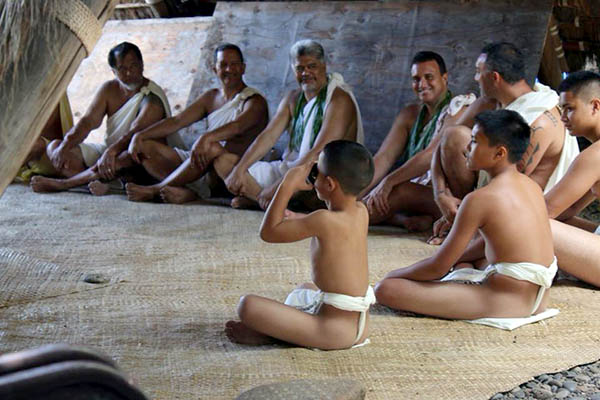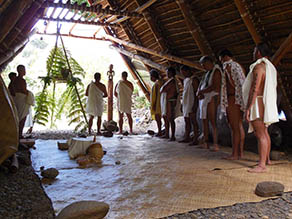 |
 |
 |
 |
||||||
|
|
|
|
|
|
|
|
|
|
 |
“Healing for all indigenous people, we all understand that healing really begins on the unseen, spiritual,” states Keola Chan. “That’s why when you do things Hawaiian style—whether you’re going to make a canoe, you’re going to sail, you’re going to plant, you’re going to fish—you start with pule. You start with your prayer. Then because you’re asking, you’re petitioning, ‘Hey, this one I’m going to do. Give me strength, give me wisdom to do these things that I’m about to physically engage in, and guide me in those areas that I may be flawed, I may have gaps. Fill me in on those areas. Ancestors, guide me. Akua, enlighten me and guide me through my work so it’d be perfect like you.’ “I’m more of a facilitator to help people through the healing process,” Kamaka admits. “We always learn that you are not the one, not the healers; Akua is the one who does the work, we’re just there to facilitate that practice, making sure that ultimately they are going to heal themselves. I mean, they would find out their own ways for heal. Sometimes it might take a while, might be a process, but we are not the healers.” 
“It is in our best interest to reconnect with our spirituality,” Keola Chan continues, “to redefine again who we are and not forget where we come from, so that those connections and relationships—not just to the present but those that have come before us—that they really ensure a better outcome for us. So, those spiritual beliefs are critical to our health and well-being. So our organization and the work that I do in healing, we confront those things. “We start by talking about our old akua, our old gods, and who they were, and why were there so many. Why did they exist? What were their relationships to us? Who are they? And getting to know them instead of demonizing, because when we demonize them, we demonize ourselves because they are us and we are them. “Healing begins really at that point on the unseen realm, that spiritual connection to those entities that come before us. That’s where healing starts. You just walk that path, keep walking it down until your ancestors, to your genealogy, to you. Those relationships aren’t fragmented from land, the space, the people that you currently walk beside. It really starts reconnecting for us, those relationships. It’s not, ‘There’s someone up there.’ It’s like, ‘No, it’s right there. That’s Kanaloa right there. That’s Kāne. That’s Kū right there.’ Keola Chan explains the Circle of Wellness model “You have all of these akua present, so then you have a responsibility not just to them, but how you use them. You’re going to cut down all the coconut, you’re going to take down all the bananas, just because you can? Know that there’s repercussions if you do stuff like that. You take only what you need. You get more than you need, you share with others. It puts your world, and your actions or reactions into a different mindset when you reconnect to those spiritual beliefs again and really evaluate. “You like heal somebody, the physical, easy to, but it’s the unseen realm that in our healing practices today in our society, they don’t really look at. It’s not on the discussion. I was fortunate because I had so many different lomilomi schools. lomilomi is like one big umbrella, and under that umbrella, it’s a huge spectrum of different styles, philosophies, approaches, techniques. “I tell students ‘we’re going to learn all that stuff and we’re going to talk about who I learned, what from, and why this technique we should use on this time. And maybe when that person come in with the different problems, we’re going to use this technique.’ There’s all of those facets that you learn. But to me, those are the easy parts."
Keola discusses the role of religion “As far as a formal practice, I incorporate a lot of the different aspects,” Kamaka explains. “I was able to work with Auntie Malia Craver, I was able to sit in on her classes when she did her class at Queen Lili‘uokalani Childrens Center. A lot of that ho‘oponopono practice was built more for working with the families. So working with the individuals, I use a lot of those similar aspects of that kūkulu kumuhana—getting to know the issues at hand and all. It is important, I feel, to get to know people and build relationships. “It is important to be able to uncover and address those underlying issues. Sometimes it’s a process to uncover all those different layers. They always talk about the onion: all those different layers, they need to be uncovered to get down to that root cause of the issue. So sometimes it’s not just one session that we can resolve someone’s issues. It might take a few sessions for us to build that relationship with somebody so they feel comfortable telling us their deep issues. “A wahine is not going to tell you that they were sexually abused as a young child if they don’t really know you. Once they feel comfortable with you, then they’re going to feel more comfortable saying these issues—once they know that trust, once they know you’re not going to be telling people about their issues. Then they might feel more comfortable telling you that they were abused as a young child. Or they were fooling around on their husband or their wife. And some of that stuff like really bogs on people. “Just being sexually abused for people is hard to overcome. And these relationships, sometimes forgiveness of a parent for talking down to them for a long time. It has a big burden on people. It takes a while sometimes for people to feel comfortable sharing those experiences with us. But then again, everybody is different. I’ve worked with people and the first time they saw me, they were able to tell me their deep issues. So everybody’s different. And that’s the beauty of this work too, is that everybody’s experience is different. Everybody has their own stories that they will be bringing to you. Everybody’s story is different. “And we get to hear the stories. These people that come to us share with us stuff they didn’t even share sometimes even with their significant other. They tell us stuff that they didn’t even share with their husband or wife. So this is a special work and I feel blessed to be able to do it. When people give us a call for needing our service, sometimes we see them one time, and then if they don’t call us back, I take it as they are good! That we were able to address their issues and now they can do for themselves, which is the whole goal. We don’t like to see people all the time. After a couple times I’m like, ‘You know, I’m probably not the right person for you. You’ve got to go maybe see somebody else to help you address these issues.’ “Afterwards, I always tell people for go into the ocean. It’s kind of like the closing, a cleansing. Cleansing is important for our practice. You know how some machines got that little button on the back, that restart button? Every so often we got to press that restart button to restore ourselves. That has always been important to me in my practices—getting into the ocean, making sure that we’re fresh, both for the people and also for ourselves. If I don’t feel good, I’m not going to work on nobody. I’ve done it in the past where you just hammer through, even if you were a little ma‘i. I’ll still do it if people need the work. But I prefer to do the work when I feel good. When my cup is full and my belly full, then we can help other people. “I try to protect myself, I try to make sure I pule before I do the work, just to kind of like protect myself, protect the person that I’m working on.” “And then at the end,” Keola admonishes, “thanking them, praising them, giving them the glory, respect, acknowledgement for what you just did. Those pieces are important in doing lomi. It’s being humble enough to say, ‘I don’t know everything.’ That’s really important in our work, is understanding that you have some skill, you have some knowledge, maybe even a little bit of wisdom, but you don’t know everything. Be humble enough to understand that it comes from something greater than you. “If you can understand that in your work, then it becomes much easier to ‘heal’ somebody. But just in that word, then the healing doesn’t really happen from you. That is something larger that took place. Be humble, as they say. Be humble, be respectful, and know the fullness of the responsibility you take on when you bring somebody within a space that you’re going to shed their problems upon your space, and what is your responsibility to clean that up, how you clean that up.” Keola Chan talks about the importance of spaces for healing “Not just physically; maybe they drool, bleed, sweat, scream, yell, swear, cry in your space. How do you deal with all that? Healing is really about love. That’s why you got to love yourself first. You got to have love for your ancestors more deeper than that. That’s where it stems; love for those that have come before you, love for your akua. And in doing those things, then you love yourself; and in loving yourself, you can expand that to those around you and do it unconditionally, to love somebody in that way, because it comes from something unexplainable, unfathomable. “That love, that ability to share love in a way that you can help restore mana, restore life, restore the gift of breath and ease them back into the world. That’s love.” There are also stories and traditions of magical healing And on the flip side, stories of sorcery to cause illness or harm.
|
 |
|||||||
 |
Healing is also aided by the stories told about places and peoples of old. These stories are like Footprints left by the ancestors, showing us a path to follow.
|
 |
||
 |
|
 |
||

|
 |
||||
|
||||
Copyright 2019 Pacific Worlds & Associates • Usage Policy • Webmaster |
||||




